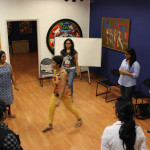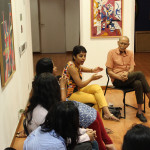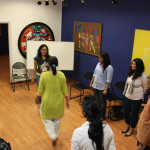On 28th of July 2015, PeaceWorks hosted two storytellers from Ever After, Bangalore—Deeptha Vivekanand and Nisha Abdulla. Deeptha and Nisha conducted a story-telling workshop with the volunteers of the Peaceworks “Share Stories Open Minds” Project; the main purpose of the workshop being the exploration of new techniques to reiterate old stories.
At the onset of the workshop the volunteers were asked to introduce themselves through an interesting activity of taking one’s name and switching places with them. Thereafter, the focus shifted on some specific problems that the volunteers were facing while conducting their story-telling sessions. This contemplation brought forth problems like managing a large group of children all at once, managing children of various age groups at the same time and perspectives of the teachers in some centers.
After discussing these problems, certain techniques were shared by Deeptha and Nisha. Some of these techniques are:
- Action– where a short story is told via simple and easy- to- understand actions. These stories can be warm- up stories to attract the attention of the children. It becomes easier to manage a large group of children through action stories.
- Mime– (Quite similar to Dumb charades). A few gestures and their meanings are randomly told to the audience first. Thereafter those gestures are arranged in a chronological order, with the meanings coming from the audiences, is used to build up a story.
- Drawing– Children always enjoy visual representations of a story. This allows them to visualize the story and use their imagination while drawing it.
- Song– A song always adds a rhythm to the story. If the song is repeated once or twice the children start humming it too.
- Perspective– it is important to be broad-minded while discussing perspectives. The way children perceive things and the way adults perceive it is completely different. Thus one should always let different perceptions come into the forefront. It helps build opinions in people.
- Call and response –is another effective technique where a story is told by enacting it. The storyteller often becomes the narrator in these cases and the members of the audience become the key characters in the story.
It is said in any activity there is scope for improvisation thus after learning these techniques it becomes the responsibility of the volunteers to improvise on them with new and different stories to engage the audience’s attention and also to evoke a certain responses from them.
On this note a very fruitful two –and-a –half-hour workshop ended with a lot to take back home from Deeptha and Nisha and to implement them in any way possible!
–Subhadrika Sen



